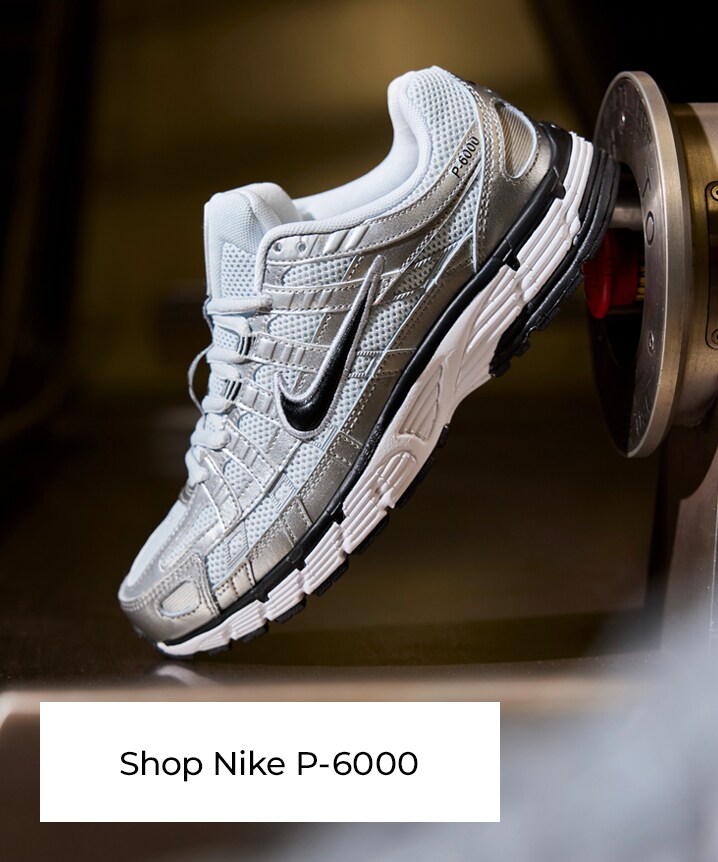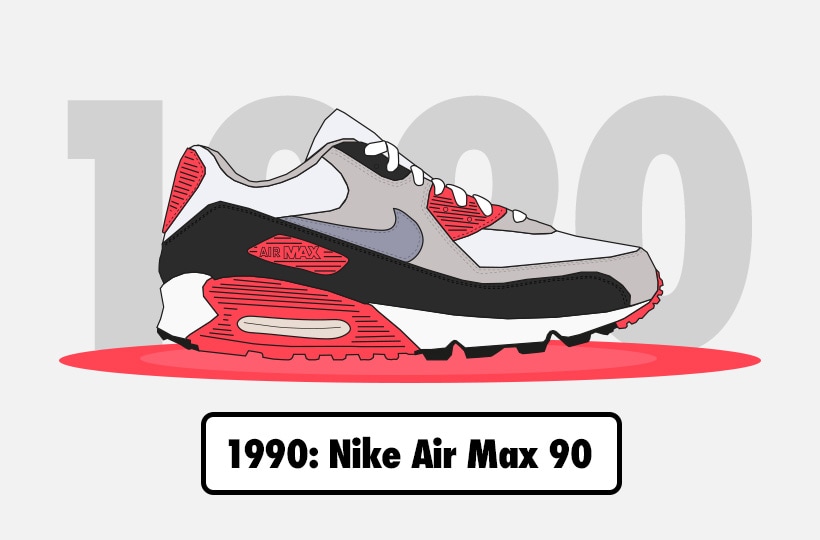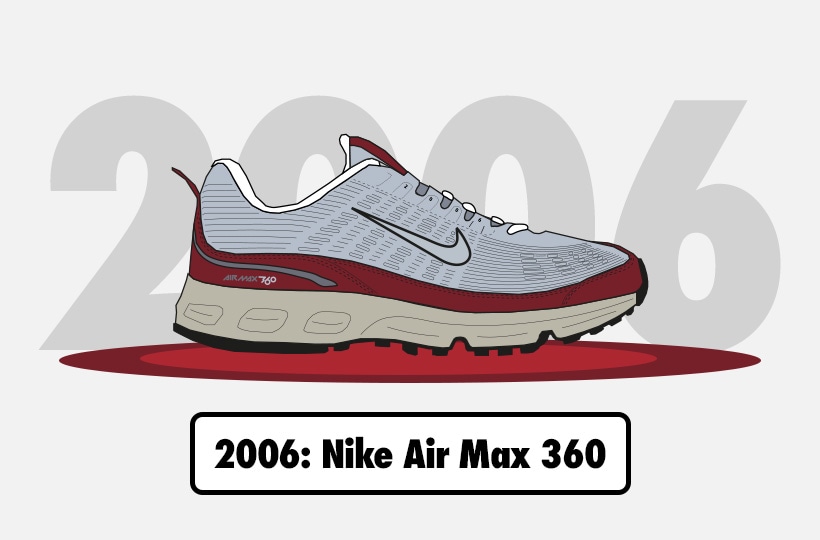Nike Air Max is an instantly recognisable sneaker franchise around the globe, but who is the mastermind behind this famous Nike trainer franchise? What is the point of a trainer full of air? Let us explain…
AN ICON WAS BORN.
Nike first introduced its revolutionary Air Cushioning Technology in 1978, changing the way athletes approached their running shoes forever. By 1987, the science behind the Nike Air unit in the shoes had advanced rapidly, meaning the cushioned air unit was bigger and comfier than ever before. This is when Nike decided to make the air unit visible, creating the first Nike Air Max trainer.
Now for the geeky stuff, and it might surprise you.
Former NASA scientist M. Frank Rudy discovered that he could take gas and pump it into a bubble that could be placed into the sole of a trainer, cool right? The problem was nobody would take him on until he knocked on the door of Nike, and as they say, the rest is history.
Ready for the whole lowdown on the Nike Air lineage? We got you. From the one that started it all - the Nike Air Tailwind to the Nike Air Max 95 hailed as one of the most recognisable Air Max silhouettes of all time discover the full Nike Air Max history right here.
THE AIR FAMILY.
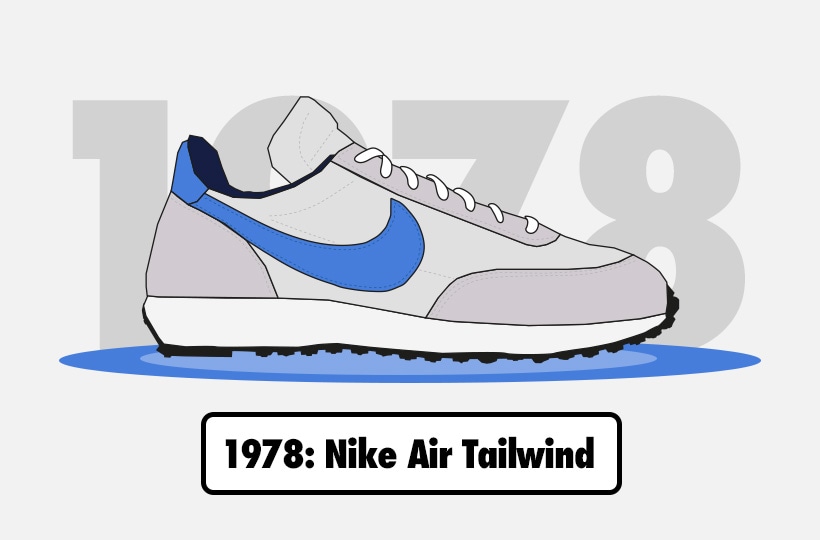
1978 NIKE AIR TAILWIND
The Swoosh that introduced the world to Air sole cushioning. It would be impossible to talk about the history of Air Max without mentioning the Nike Air Tailwind. Introduced in 1978 and released to the world in 1979 the Tailwind was the first silhouette to feature Frank Rudy's Air cushioning. Designed as a performance shoe, the streamlined and lightweight silhouette was made using suede and nylon. The shoes were originally released through six retailers in Honolulu in the lead ulead-upe marathon and sold out. A wider release followed in 1979 with Nike describing the Air sole as 'unequalled cushioning in state-of-the-art testing'.
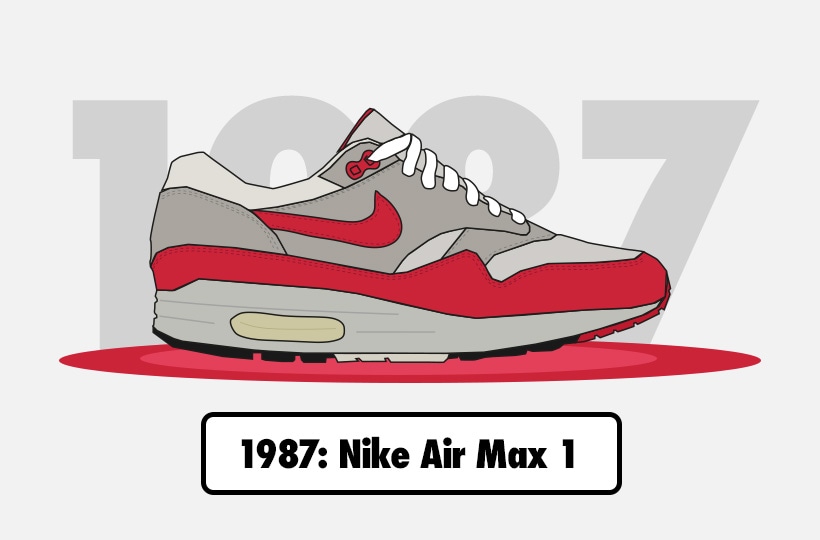
1987 NIKE AIR MAX 1
We can't talk about the Air Max 1 without introducing you to designer Tinker Hatfield. Originally hired by Nike as a corporate architect to design buildings on their Oregon campus, Hatfield began to design footwear upon request four years into his career at Nike. Hatfield applied his architectural background to his designs. Inspiration for exposing the Air Cushioned sole of the Air Max 1 came from the Centre Georges Pompidou in Paris. This building design displayed all its functional and structural elements on the outside. Released on March 26 1987, the Air Max 1 was the first silhouette to expose the Air-cushioned sole and the Air Max line was born.
1990 NIKE AIR MAX 90
Originally named the Air Max III, the Air Max 90 has become one of the most successful silhouettes in Nike history. Hatfield had been tasked with taking the successful silhouette of the Air Max 1 and elevating it in terms of function and style, similar to the Air Jordan lineage. The Air Max 90 highlighted an enhanced Air bubble and its original 'Infrared' colourway with a bold neon red and pink combination helped to cement this sneaker as one of the most famous trainers of all time.
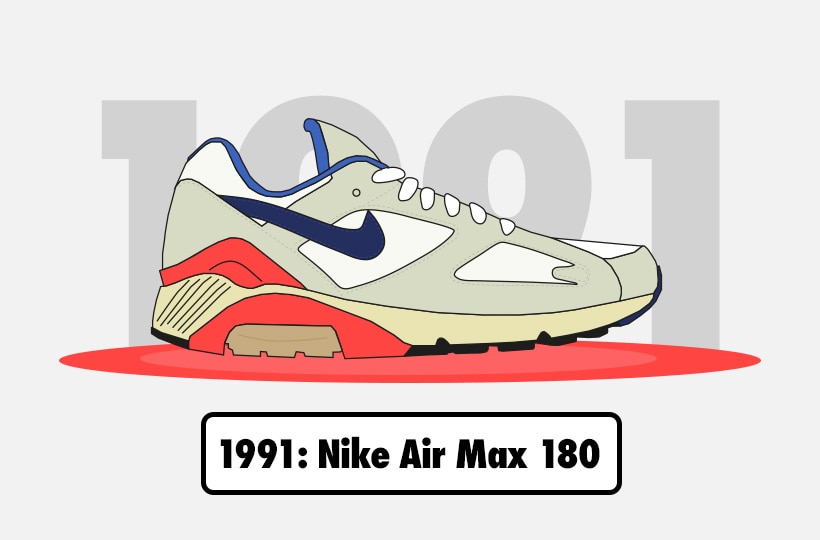
1991 NIKE AIR MAX 180
The result of a collaboration between legendary Nike designers Tinker Hatfield and Bruce Kilgore the Air Max 180 was the line's first silhouette where the Air unit made direct contact with the ground. The Air bubble was twice as big and was spread 180 degrees across the sole. Unfortunately, when the silhouette was released it didn't see the same success as the Air Max 1 or 90, despite being promoted by Michael Jordan during the 1992 Olympics. Success for the AM180 didn't arrive until 2018 when Comme des Garçons collaborated with Nike with the 'Laser Pink' pack.
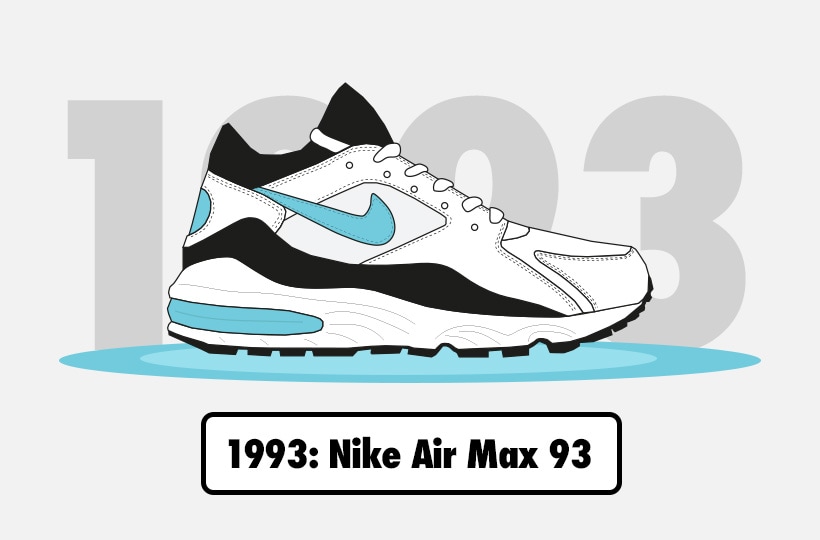
1993 NIKE AIR MAX 93
Taking inspiration from the Huarache, the Air Max 93 was designed by Tinker Hatfield and was a massive step forward for Nike Air technology. The shoe featured 270 degrees of exposed Air (rumoured to be inspired by the handle on milk jugs) which was the most Air Nike had offered up to this point and would go on to inspire the Air Max 270.
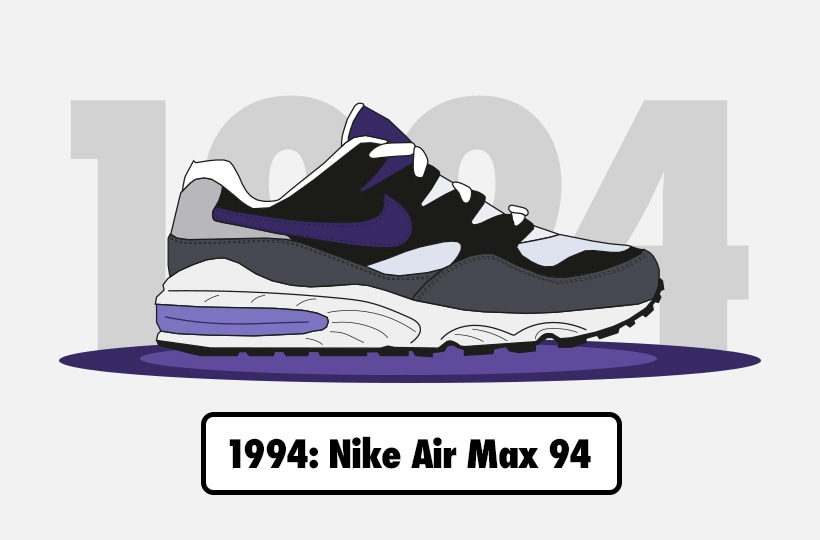
1994 NIKE AIR MAX 94
A hybrid of the Air Max Light and Air Max 93, the Nike Air Max 94 originally dropped in a Court Purple colourway. One of the lesser-known members of the Air Max family, the Air Max 93 featured a large Air Unit to the heel with nubuck overlays and mesh upper. The neoprene tongue and sock-like material gave the wearer a tighter fit similar to the fit of a Huarache.
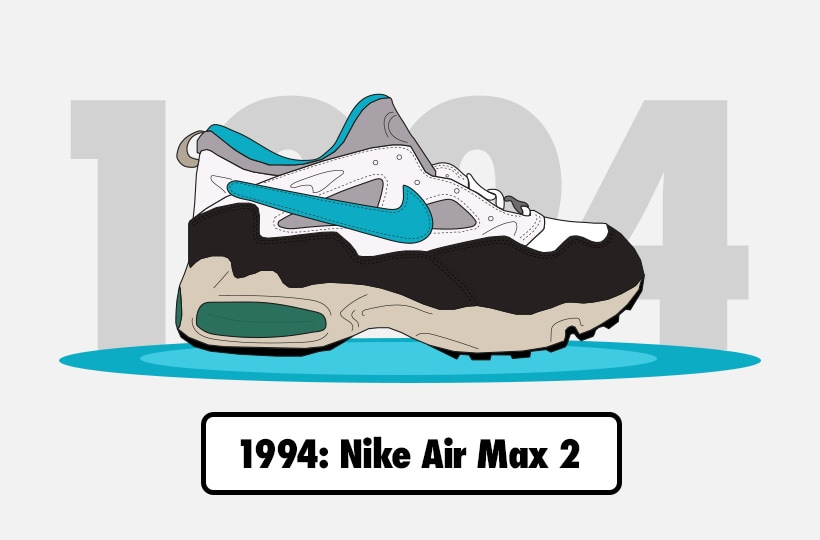
1994 NIKE AIR MAX 2
An exploration of the true behaviour of air, the four-chambered Nike Air Max 2 or Air Max Squared featured two different pressure systems within the single Air unit. The exterior chambers sat at 25 psi and offered a more solid and fir cushion, while the two interior units dropped down to 5 psi for more of a bounce.
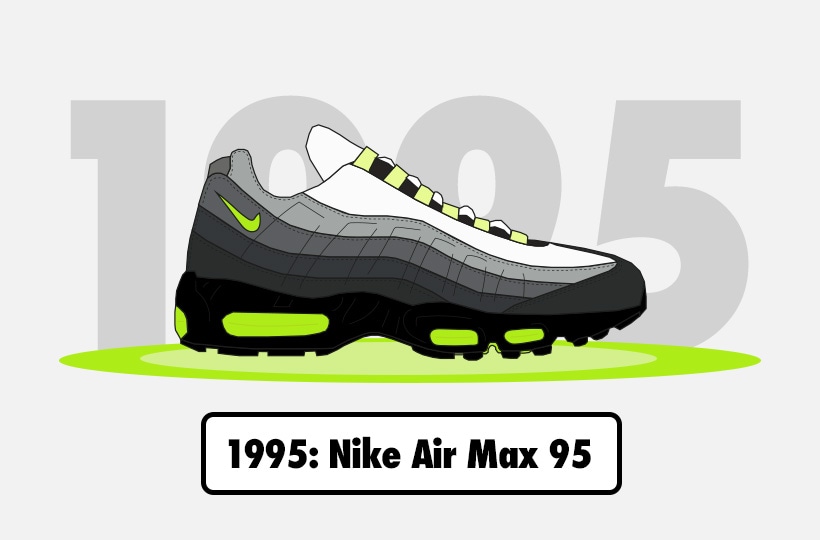
1995 NIKE AIR MAX 95
The Nike Air Max 95 took things to a whole new level, with an anatomy-inspired design and forefront Max Air cushioning the Air Max 95 was unlike any silhouette that had come before. Designed by Sergio Lozano in 1995, this silhouette was inspired by the human body, with the lacing system acting as the ribs, a spine spine-inspiredle and a mesh and suede upper representing muscle fibres.
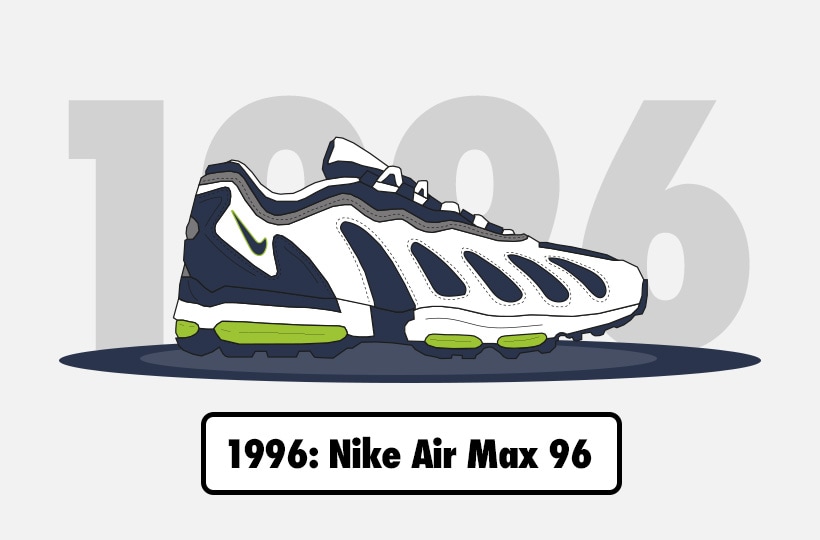
1996 NIKE AIR MAX 96
An elevation of the Air Max 95, the Air Max 96 inherited the same Max Air bag concept but with a redesign by Lozano inspired by the waves of the ocean. Four colourways were originally released, with the most recognised colourway being the Black/Dark Concord which originally featured a Scream Green Max Air bubble but was released with a black unit.
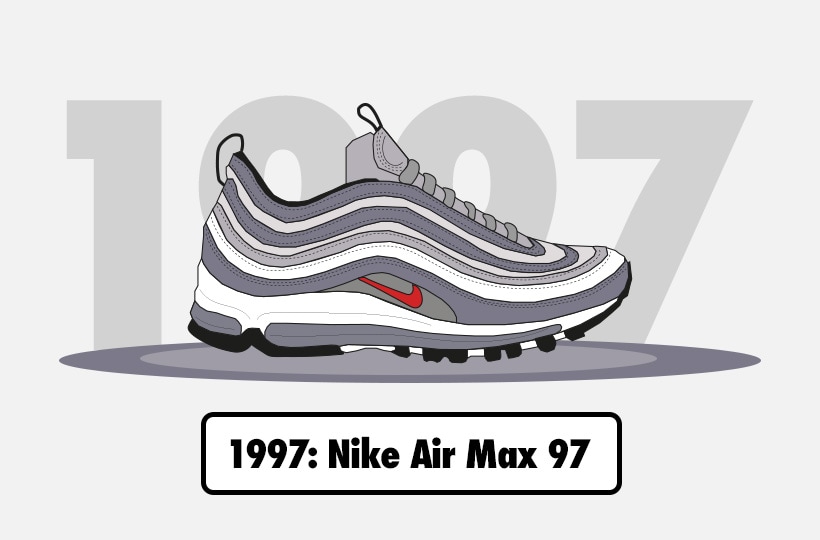
1997 NIKE AIR MAX 97
Succeeding the Air Max 96, the 1997 Nike trainer release instantly found traction in popular culture around the globe. Air Max 97 designer Christian Tresser drew inspiration from nature, and mountain bikes.
The ripples of water as a raindrop hits a puddle influenced the waves in the upper and the reflective taping was inspired by mountain bike design. The Air Max 97 also featured the first-of-its-kind concealed lacing system that completed the sleek lines; the similarities may be uncanny, but Tresser himself never referenced futuristic high-speed rail as an inspiration. It made for a cool name, though. The bullet train myth/marketing spin probably contributed somewhat to the Air Max 97 Silver Bullet's popularity, but it was the design itself and the timing of the release that catapulted the sneaker into cultural significance.
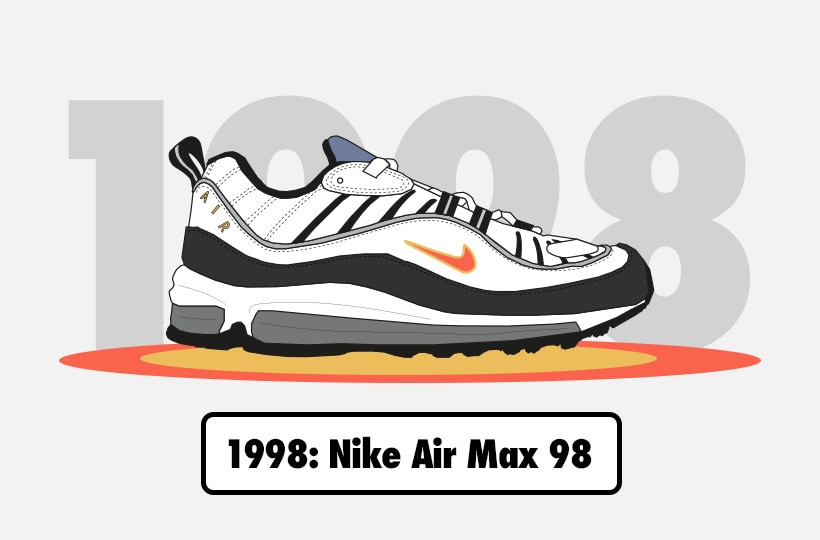
1998 NIKE AIR MAX 98
The Air Max 98 was originally touted as the best Nike running shoe available at the time. Thanks to its anatomically designed, dual pressure and full-length Air-Sole unit with a lateral crash pad system which cushioned the foot through each step.
However its bulky design and dad shoe aesthetic were unpopular in the 90s and the silhouette failed to take off until its rerelease in 2016. In April 2016, Nike launched the Air Max 98 in collaboration with Supreme with black, red, navy and cream takes on the chunky shoe, covered in patent leather or snakeskin along the sidewall and toe cap. Cue the resurgence of the dad trainer.
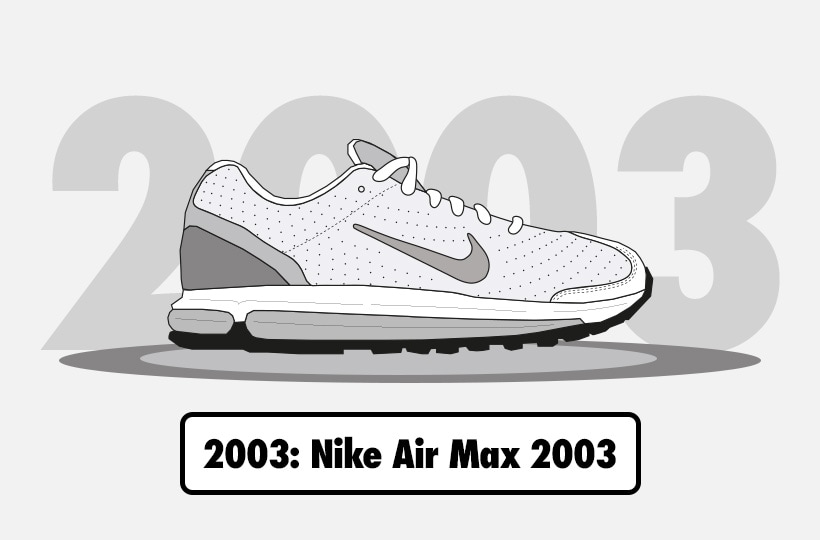
2003 NIKE AIR MAX 2003
Nike's first release of the noughties breathed fresh life into the Air Max lineage. After the chunky silhouette of the Air Max 98, the AM2003 was a sleek and clean trainer which defied the chaotic aesthetics of the late 90s. Designed by Sergio Lozano he kept all the best features of previous Air Max trainers and combined them in one monochromatic shoe. The Air unit was lower to the ground giving the wearer better flexibility.
2006 NIKE AIR MAX 360
The first trainer in history to be completely cushioned by Air. A full lfull-lengthir Unit ran from the heel to the toe and was the first of its kind.
Originally released in red ana d white colourway inspired by the Air Max 1, the 360 is one of the few Nike trainers that hasn't had the retro treatment.
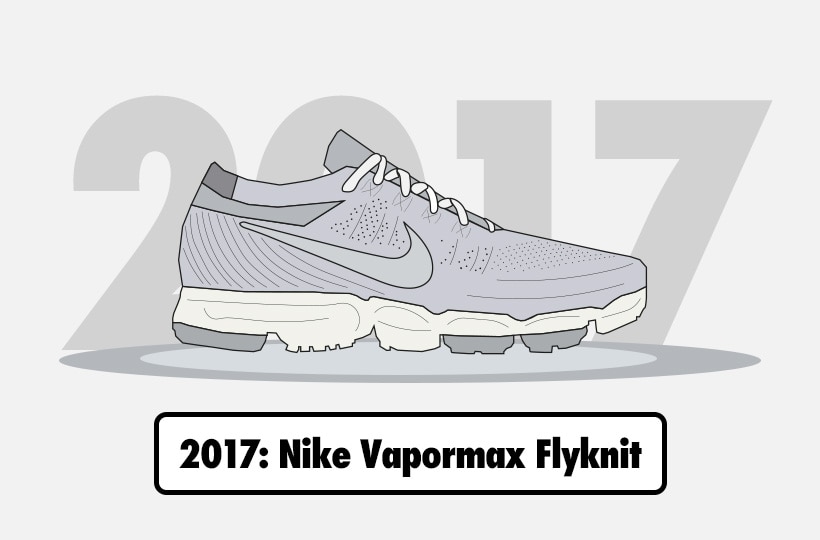
2017 NIKE VAPORMAX FLYKNIT
After seven years of research, the Nike VaporMax Flyknit was released. Designers, Tom Minami and Zachary Elder wanted to create a sneak that focused on using as little Air as possible by using it wisely to support the stride of a runner.
Moving away from the traditional trainer build of a midsole and outsole, the VaporMax has one single unit featuring connected pockets of Air. As the Air moves through the single unit the pressure points underneath the foot change giving the effect of a piston. With every step being pushed into the Air unit releases giving the wearer a springy bounce with every stride.
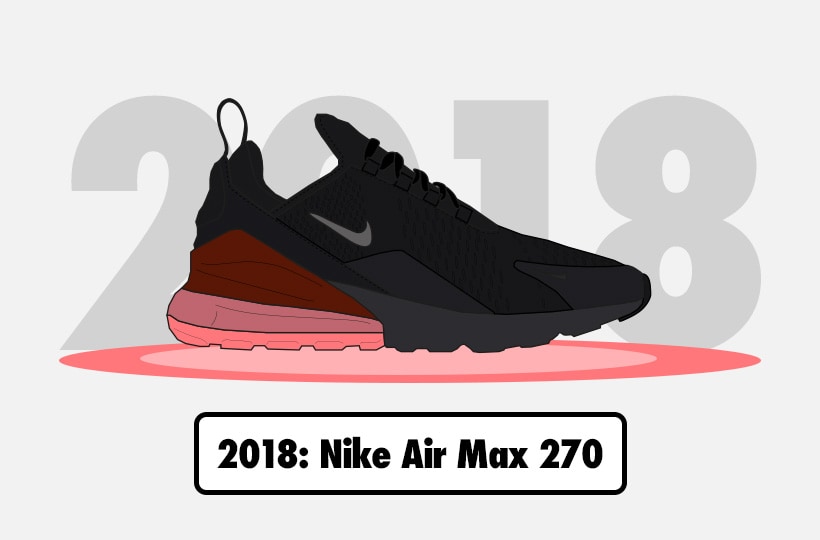
2018 NIKE AIR MAX 270
Taking inspiration from the Air Max 93 and 180, the Air Max 270 boasted the highest Air unit at the time. The 270 degrees, 32mm high bubble created a cushioning 'trampoline effect' to give unrivalled comfort.
Nike footwear designer Marie Odinot developed the upper of the Air Max 270 and revealed that the upper was inspired by the Air Max 180 and the skin was inspired by the Air Max 93.
Made from neoprene and mesh, the trainer was designed to allow feet to breathe even when worn for hours on end. The shoe’s seamless construction and integrated lacing system give a lockdown fit, leaving no room for discomfort, and providing an uncompromised, glove-like feel.
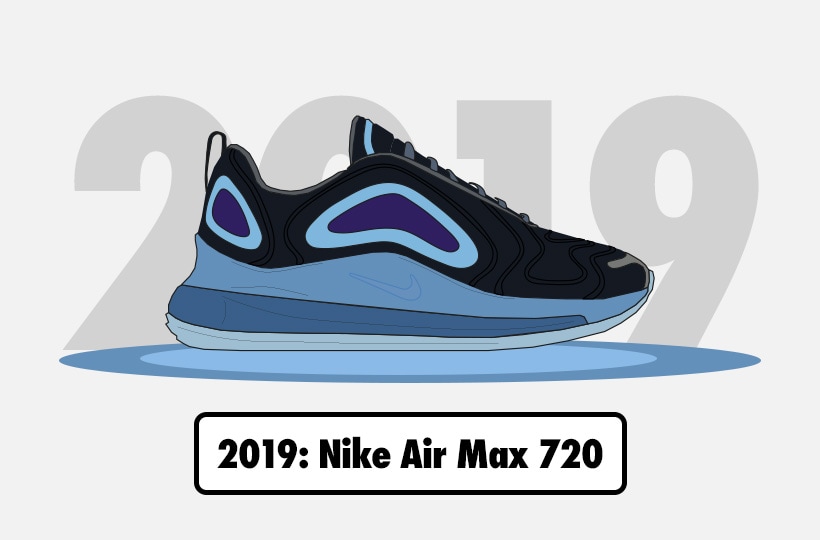
2019 NIKE AIR MAX 720
Superseding the 270, The Nike Air Max 720 was inspired by Nike's desire to continually progress their Air innovation rather than settle, the new supersized Air unit of the 720 was one of the biggest revolutions for the brand at the time.
Working to push the Air franchise to the limits, Nike wanted to create a shoe that is still functional and stylish whilst showcasing its latest technology.
With more Air underfoot than ever, the Air Max 720 shoe delivered unbeatable all-day cushioning.
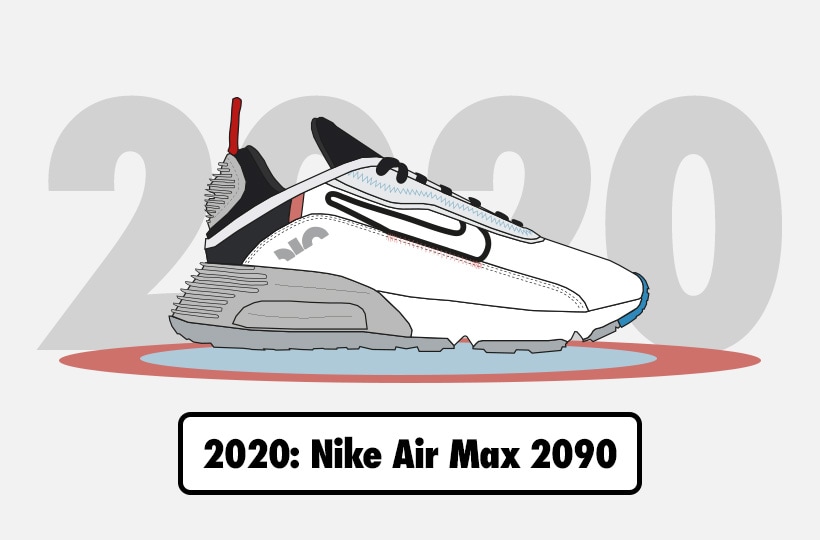
2020 NIKE AIR MAX 2090
When Tinker Hatfield designed the Air Max 90 in 1990 he kickstarted an Air revolution which hasn't shown any signs of slowing down since. The Air Max 2090 takes the AM90 and upgrades it to the next level.
Paying homage to the iconic Air Max 90 the 2090 features the classic mudguard and the unmistakable Air Max 90 Casette which highlights the iconic Air unit. Colour blocking was a key element in the Air Max 90 design with darker colours underscoring the strength of the shoe's structure and the 2090 is no different. The Air Max 2090 refreshes this element through levels of opacity, with the materials providing the most support being 100% opaque with the lightelighter-weightials being see-through.
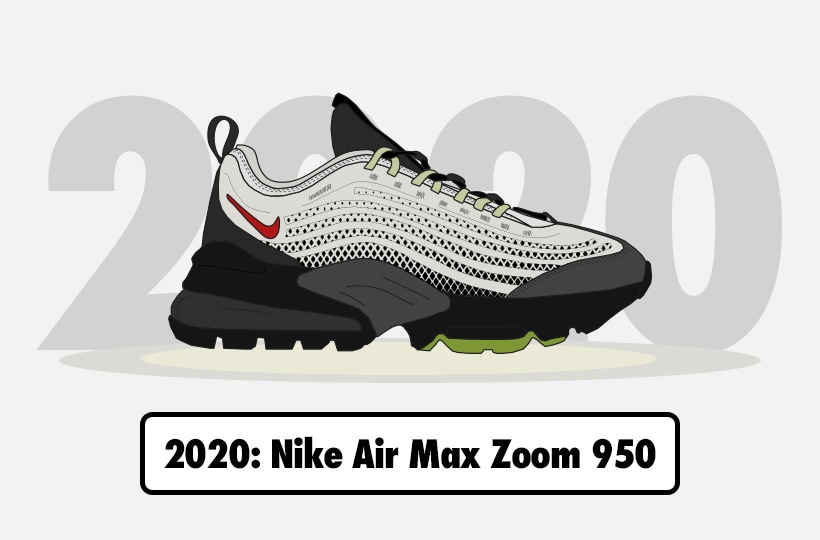
2020 Nike Air Max Zoom 950
After debuting exclusively in Japan, the Air Max Zoom 950 was released worldwide in November 2020. A tribute to the Air Max 95 in its 25th anniversary year, the Nike Zoom 950 took the 95s chunky sole and combined it with a 270 Air heel unit.
A breathable mesh upper offered optimal flexibility and comfort while leather overlays provided added security and stability.
For added security and stability, leather overlays have been added to the ZM950 and a utility-style lace-up fastening means you can create the perfect fit around your foot.
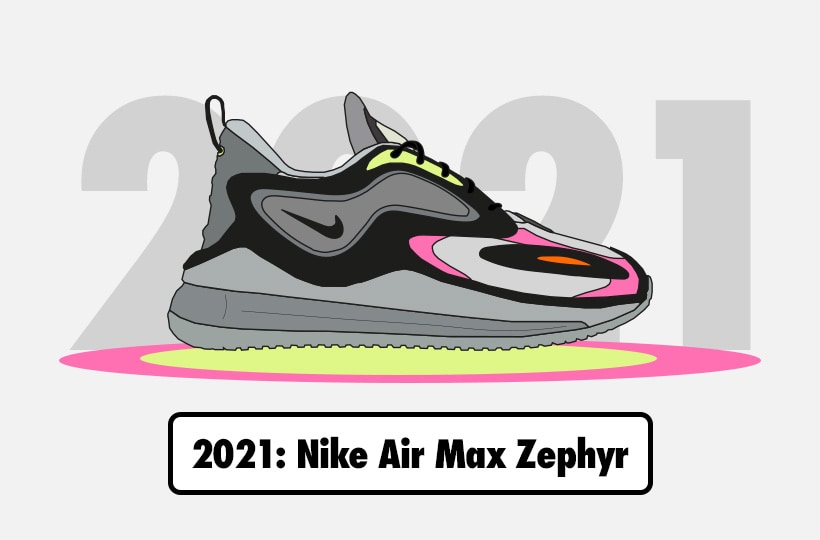
2021 Nike Air Max Zephyr
Taking its name from the Greek personification of the west wind, the Nike Air Max Zephyr combined a futuristic aesthetic with Nike's legendary Air technology.
Zonal air units to the side of the trainers added cushioning and support and similar to the LeBron 18 the Air Max Zephyr, featured two large angular Air units on the tongue.
Running the whole length of the shoe a translucent 720 Air unit underfoot delivered unrivalled comfort alongside no-sew skins and a padded collar to elevate that es your every step.
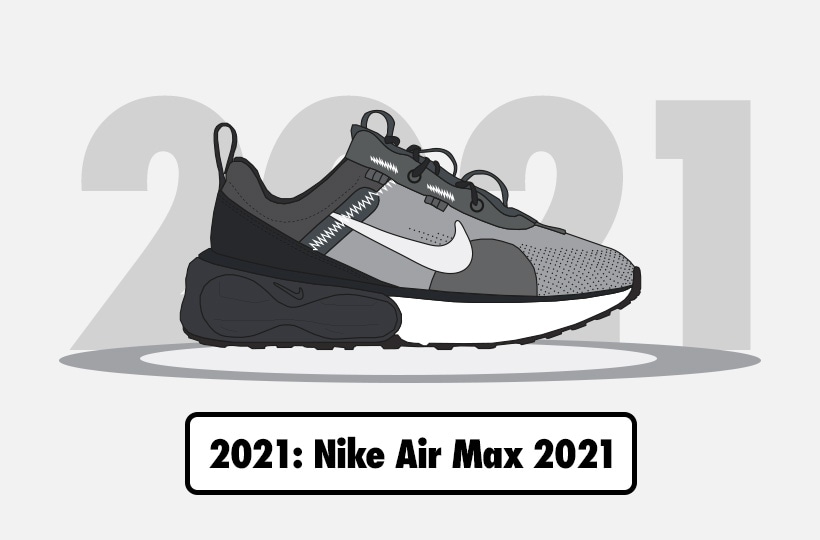
2021 Nike Air Max 2021
The Air Max 2021 featured the most revolutionary Air unit to date as well as being designed using at least 20% recycled materials by weight.
The Air-sole unit collaborates with a collapsible cage, and a foam midsole which is split into two sections and cored out (like a honeycomb) for lightweight cushioning that lasts.
The upper is made up of engineered mesh, woven textile and no-sew skins durable, airy and sleek look.
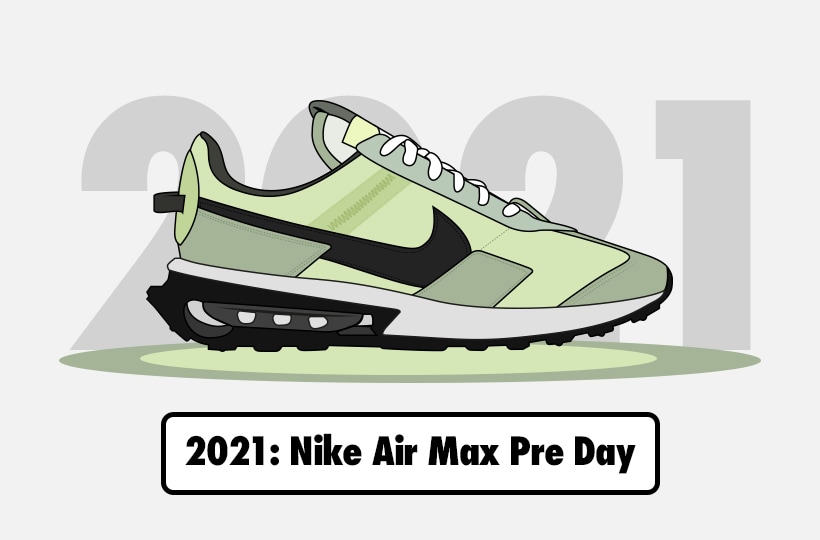
2021 Nike Air Max Pre Day
Inspired by American Long Distance Runner Steve Prefontaine, the Nike Air Max Pre Day combines history with progression. Sustainable materials merged with 70s aesthetics to create the ultimate retro runner.
A 100% recycled polyester upper features bold lines and panelling underpinned by a foam midsole with an Air window in the heel. 13% Nike Grind Rubber adds traction and durability.
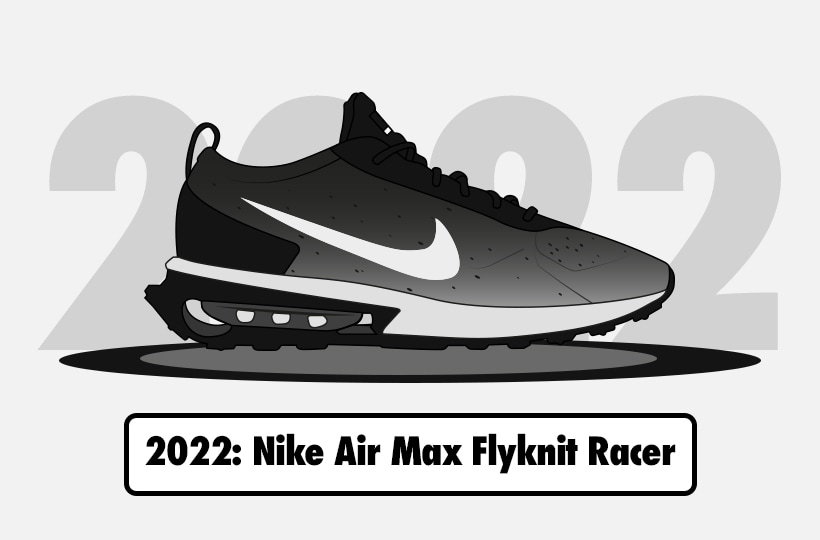 2021 Nike Air Max Flyknit Racer
2021 Nike Air Max Flyknit Racer
A perfect blend of two icons, the Nike Air Max Flyknit Racer went beyond what was expected of a Nike trainer. Combining Flyknit with Air Max cushioning was a match made in sneaker heaven.
The upper was inspired by the 2012 Flyknit racer, taking its featherweight form-fitting and seamless design to create a sporty upper that evolutionists the Air Max game. The Flyknit Racer's chiselled heel and window around the Air Max cushioning come from the Air Max Pre-Day to deliver a new take on comfort.
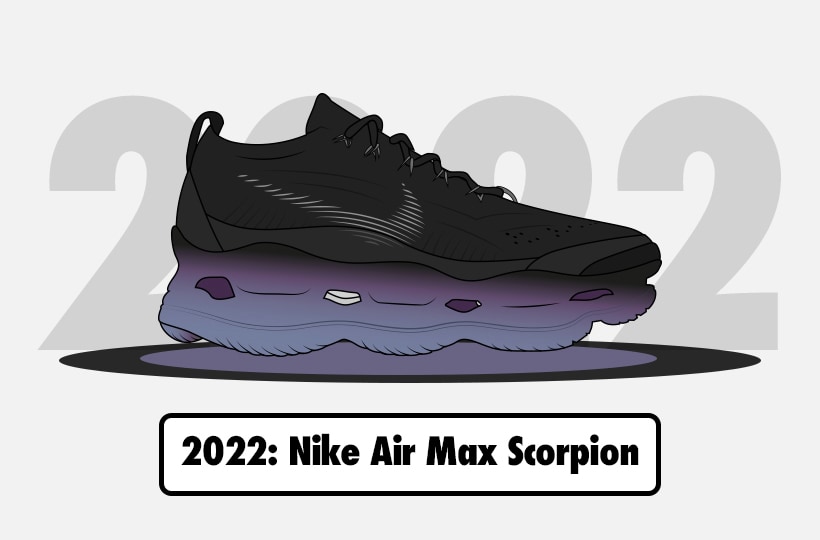 2021 Nike Air Max Scorpion
2021 Nike Air Max Scorpion
An Air Max shoe like no other. Launched in October 2022, the Nike Air Max Scorpion's design and construction took place during the Covid pandemic when most people were instructed to work from home. Nike designers, engineers and scientists produced next-level computer programmes and VR software to allow collaboration between teams. Taking just 18 months from concept to launch, the Air Max Scorpion is a symbol of collaboration.
The name comes from the sole unit, which resembles the outline of a scorpion thanks to the footpad at the forefoot and tail at the heel, building on the success of the Air Max VaporMax the Scorpion was designed from the sole up with unlikely inspiration coming from car manufacturing.
Check out the full
Air Max collection now to get your little piece of history.



















